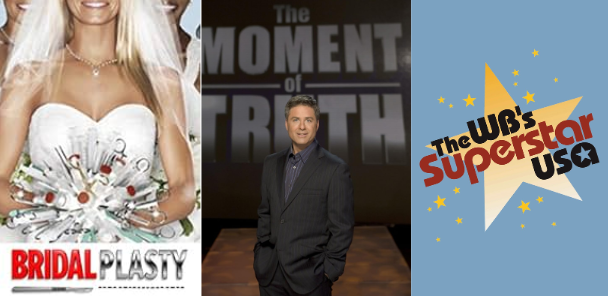I, for one, do not enjoy watching television shows that make me question my faith in humanity.
For me, such entertainment warrants virtually an identical reaction each time I watch: cringing in my seat, groaning in second-hand embarrassment, and watching in horror as my stomach sinks to unspeakable levels. Over the years, as I have—unfortunately, I may add—accrued a scarily considerable amount of time watching 2000’s reality shows, I have found that about 90% of them leave me with my thumb hovering over the power button on my television, both a visceral and impulsive reaction that I have experienced from seeing the inhumane shows that were sugarcoated as mere, every-day entertainment.
And unlike many programs today, these cutthroat series held absolutely nothing back.
One of the first Y2K reality television shows I stumbled upon was a one-season-long singing competition called “Superstar USA.” Its differentiating factor was that, while shows like American Idol and The Voice searched for the country’s most talented singers, this show eliminated the contestants with gifted vocals and picked two of the most tone-deaf, painfully off-key singers they could find for the sole purpose of gas-lighting them into thinking that they could be the worlds next big pop star. These contestants, who were fueled by their lifelong aspirations of being serious performing artists, spent almost one month being tricked by choreographers, producers, and the rest of the show’s staff into thinking that their dreams would finally come to fruition. Producers of the show even gathered audiences for the performances by telling people that the contestants were all terminally ill, and as their final wish, both patients decided to live out their wildest fantasy of becoming a famous singer, an opportunity that was granted by a falsified charitable organization called “One Wish,” a spoof of the Make a Wish Foundation.
The “winner” of this series, a young woman named Jamie Foss, spent the majority of her time on the show being mocked and patronized by the three judges, those of whom spent an absurd amount of time cracking easily transparent innuendos and jokes at her, most of which were overtly sexual. On the final episode of what should have been one of the most joyous days of her life, Jamie was instead told in front of an entire live studio audience that the entire show was a facade meant to find the worst singer in America and condescendingly torment them for a month. Canceled after only one season, it was verging on impossible to sit through an entire episode of watching a conceited TV crew build false optimism in innocent, hopeful people.
Outside of staged talent tournaments, another quotidian theme of 2000s reality TV shows was beauty makeovers. The most infamous of these drab-to-fab transformation shows was a 2010 series entitled “Bridalplasty.” In each installment, 12 brides packed their bags and moved into one giant machine with one goal in mind; no, the objective was not to win an elegant venue, a gorgeous dress, or even prize money. The grand prize is that, at the end of the game, one “lucky” bride would earn a plethora of plastic surgery operations to choose from prior to their wedding date. By the end of the show, most of the women looked almost unrecognizable compared to their former appearance, with reconstructed features from head to toe. Noses were reformed, lips were plumped, and body parts were primped and pampered to the “perfect” Barbie doll image. The most notable change built, however, was not a new hairline, but the detrimental effect it had on those watching. In a generation where the popularity of cosmetic surgeries was quickly growing, the last thing that viewers, both old and young, needed to see was a clan of women going to war over making themselves look like carbon copies of Kim Kardashian. After one season, this show was thankfully taken off of streaming platforms after it was rightfully dubbed as “too gory and diabolical for mass audiences,” an abolition that may have saved the self-esteem and image of many young, impressionable watchers.
The most twisted reality show I have managed to find hidden deep in the crevices of the internet was “Moment of Truth,” with episodes that quite literally made my insides turn while watching. In this show, participants partake in a polygraph test—more commonly known as a lie detector test—prior to their episode in which they are probed by 21 deeply personal questions. The same 21 questions are then read live on air to the contestants and with every question answered honestly, an additional sum of money is accumulated. If one answers all 21 questions correctly, they will earn themselves $500,000.
While these questions started seemingly shallow and innocent, they quickly progressed into extremely deep and introspective questions, many of which could and would permanently alter lives. On many occasions, contestants would walk into the studio in happy marriages and with strong familial bonds, and walk out with shattered relationships, tarnished reputations, and even grave criminal charges.
In one highly controversial episode, a woman admitted to millions of people—whilst her husband and entire family sat directly in front of her—that she thought her ex-boyfriend should be her rightful spouse and that she had cheated on her lawfully wedded partner on multiple occasions. The host of the show, Mark L. Wahlberg (not affiliated with actor Mark Wahlberg), later went on to say that he had protested for that episode not to be aired, as it was “the most uncomfortable situation he had ever been in on television.” She lost every single dollar she accumulated after answering “Yes” to the question “Do you think you are a good person?”
The show was canceled in Aug. of 2008, abandoning an additional 13 episodes of unaired footage. This cancellation, a product of both negative reviews and little revenue generated throughout season one, happened to scrap the only episode out of the 23 total filmed where a participant completed all 21 questions. This player, a woman named Melanie Williams, went home with the grand prize in her pocket after unveiling her suspicions that her father had inappropriate relations with a minor as an adult. While this episode never made it to the big screens, her shocking answers were picked up by news sites and were published online regardless.
While reality TV has slowly evolved into a less underhanded genre over time, looking back on the apathetic nature of many of this century’s earliest reality television shows manifests a much-needed reminder to learn from the past and continuously make advances to stray from this kind of TV program. The exploitation of contestants, the manipulation of their emotions, and the callous disregard for their well-being are all stark reminders of the dark underbelly of the 2000s entertainment industry. These programs and many more, while perhaps captivating to some, only instill viewers with a sour aftertaste of unease and deep-seated discomfort. Needless to say, entertainment should not come at the expense of watching the lives of real, living people be shattered.


























































































